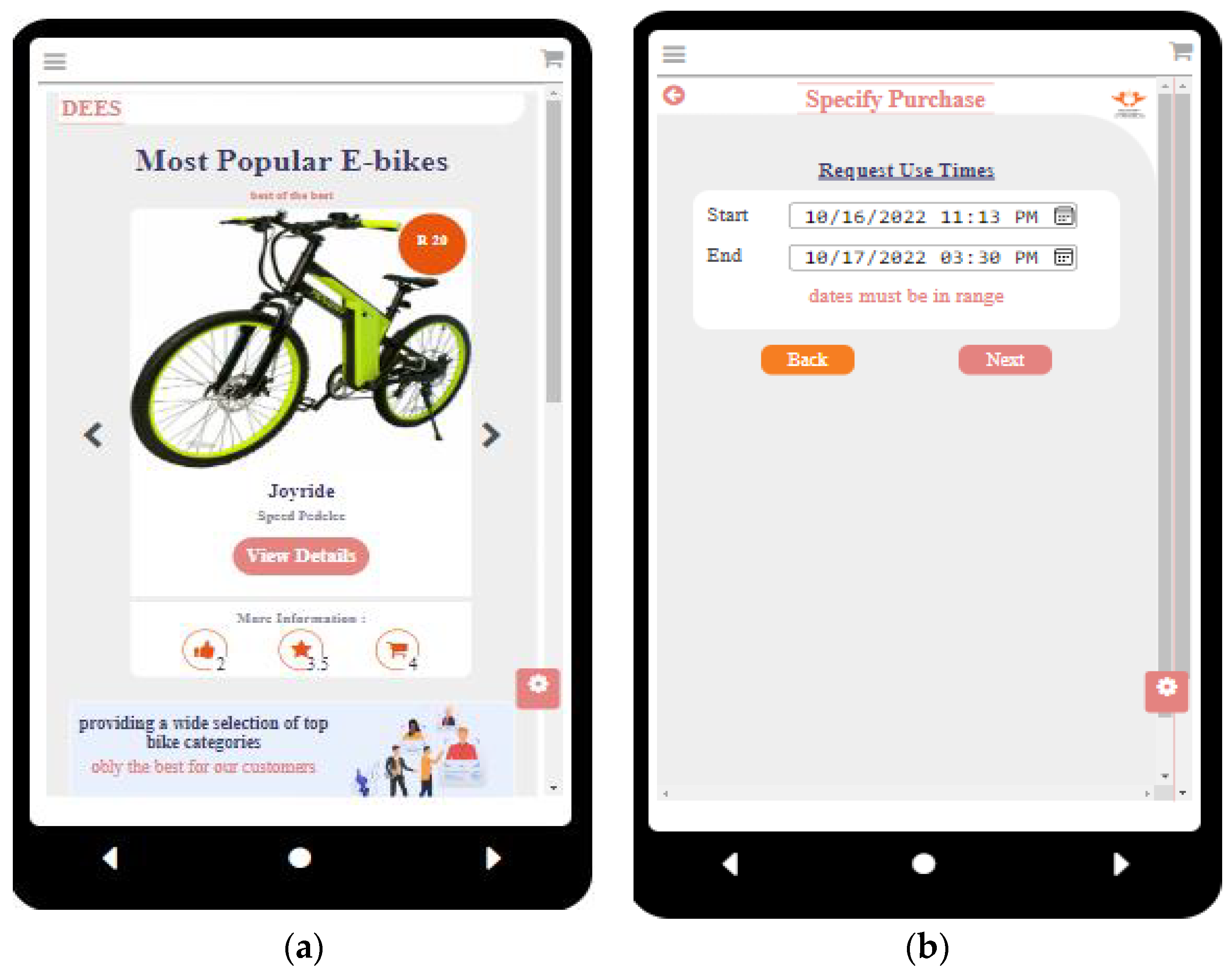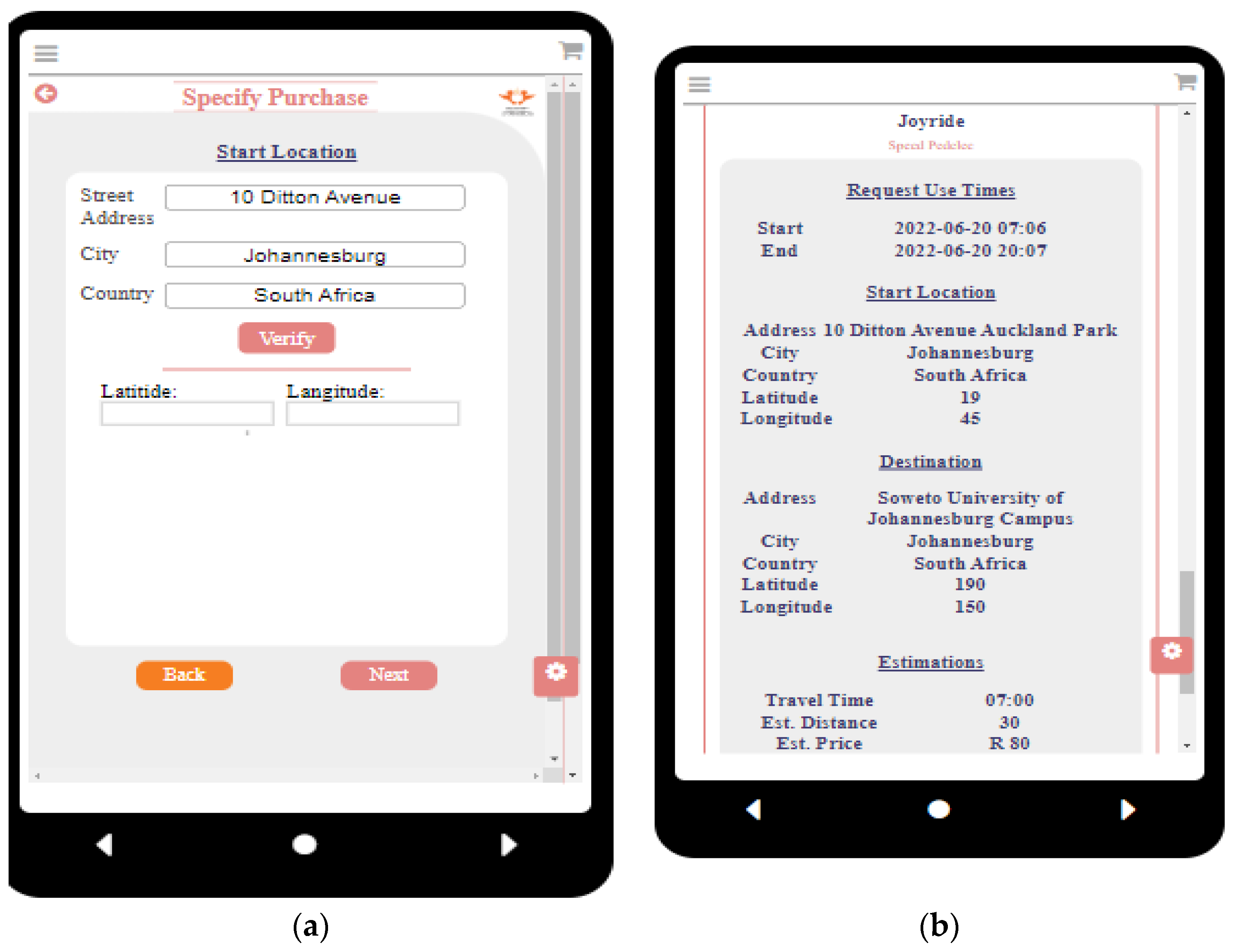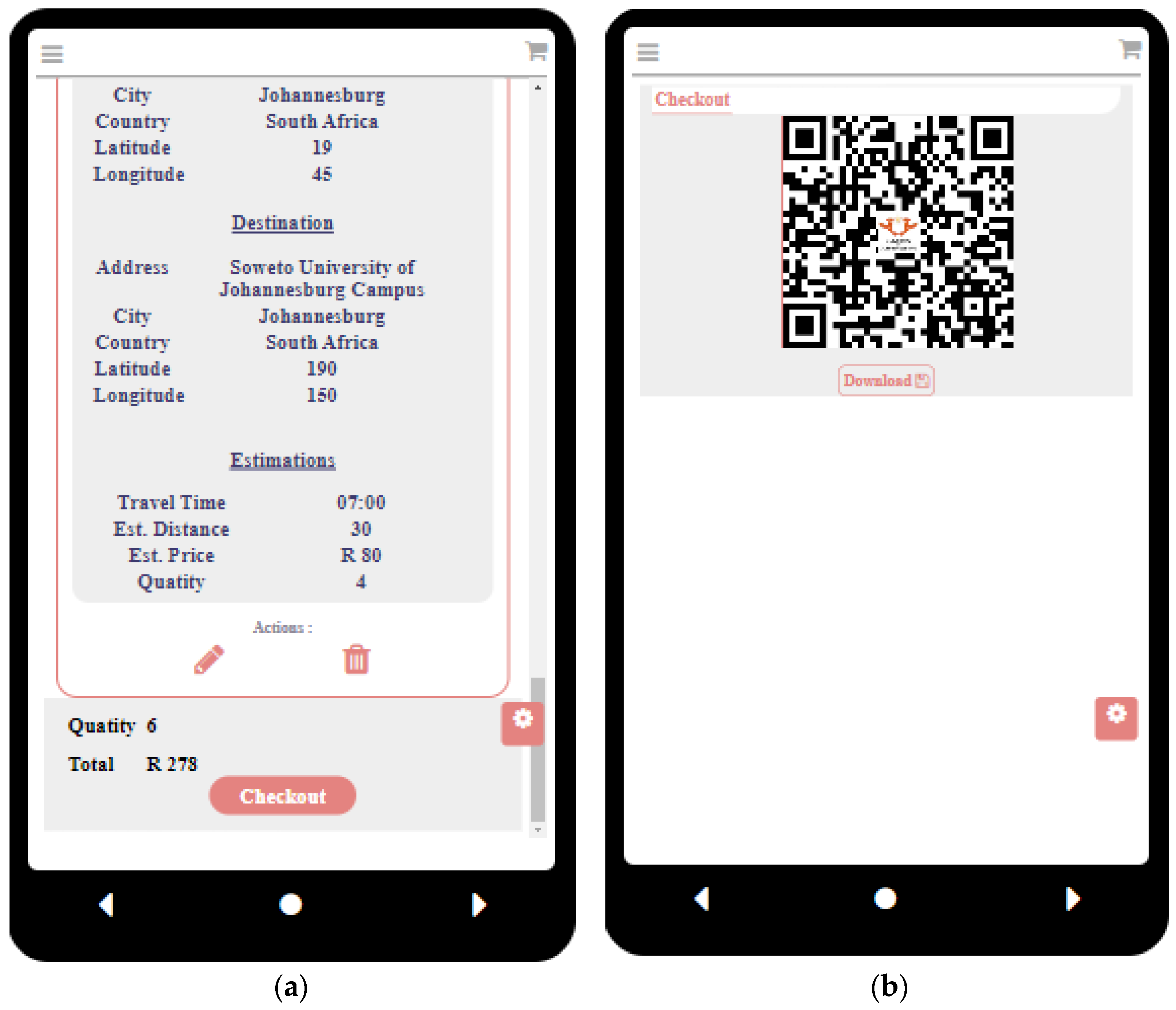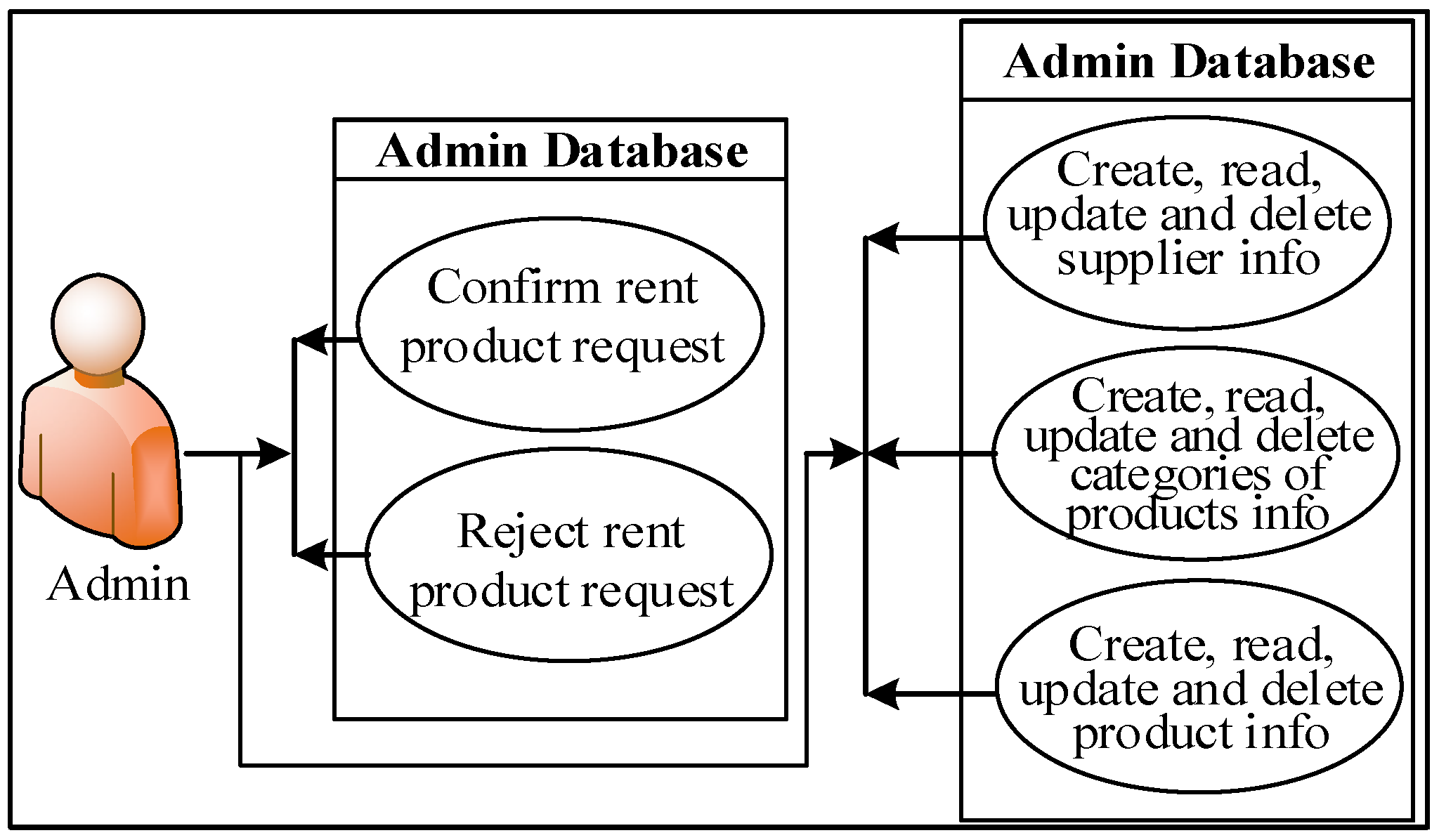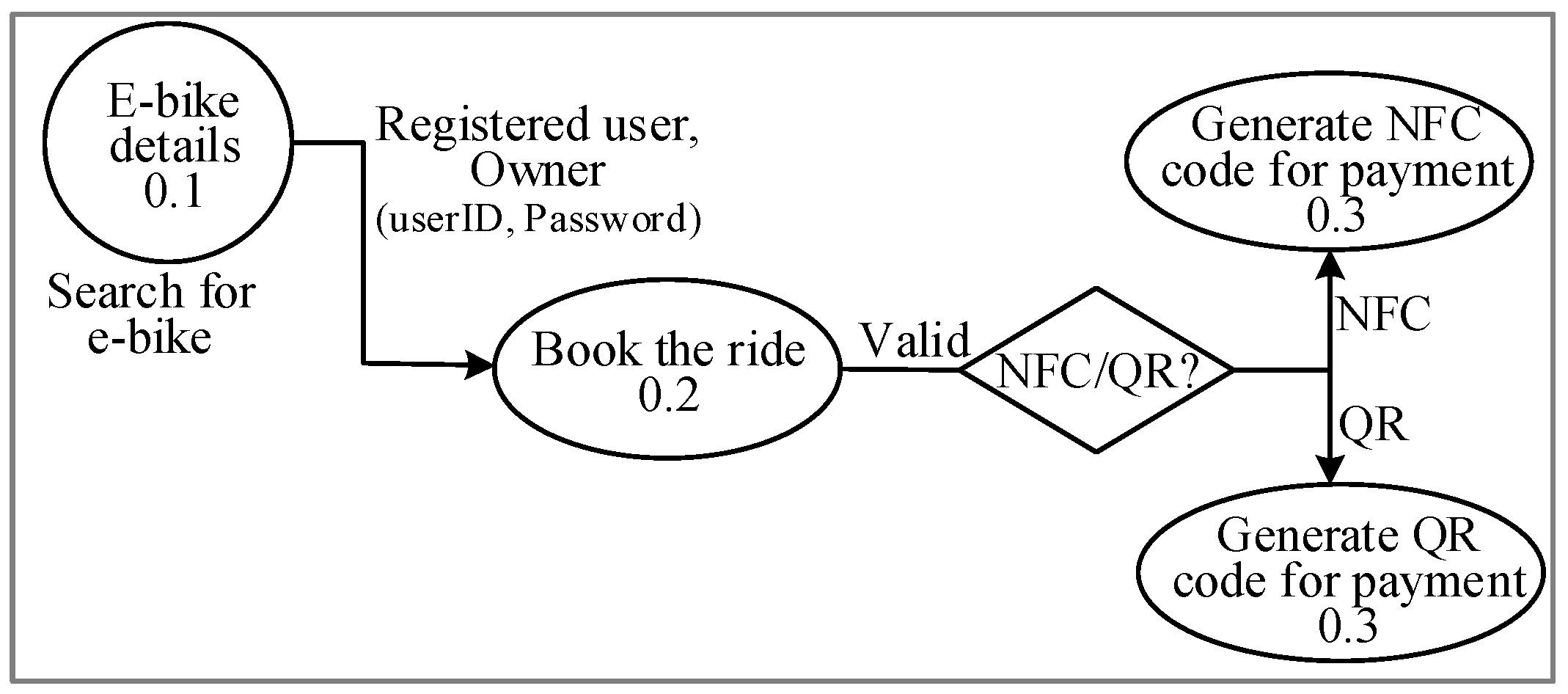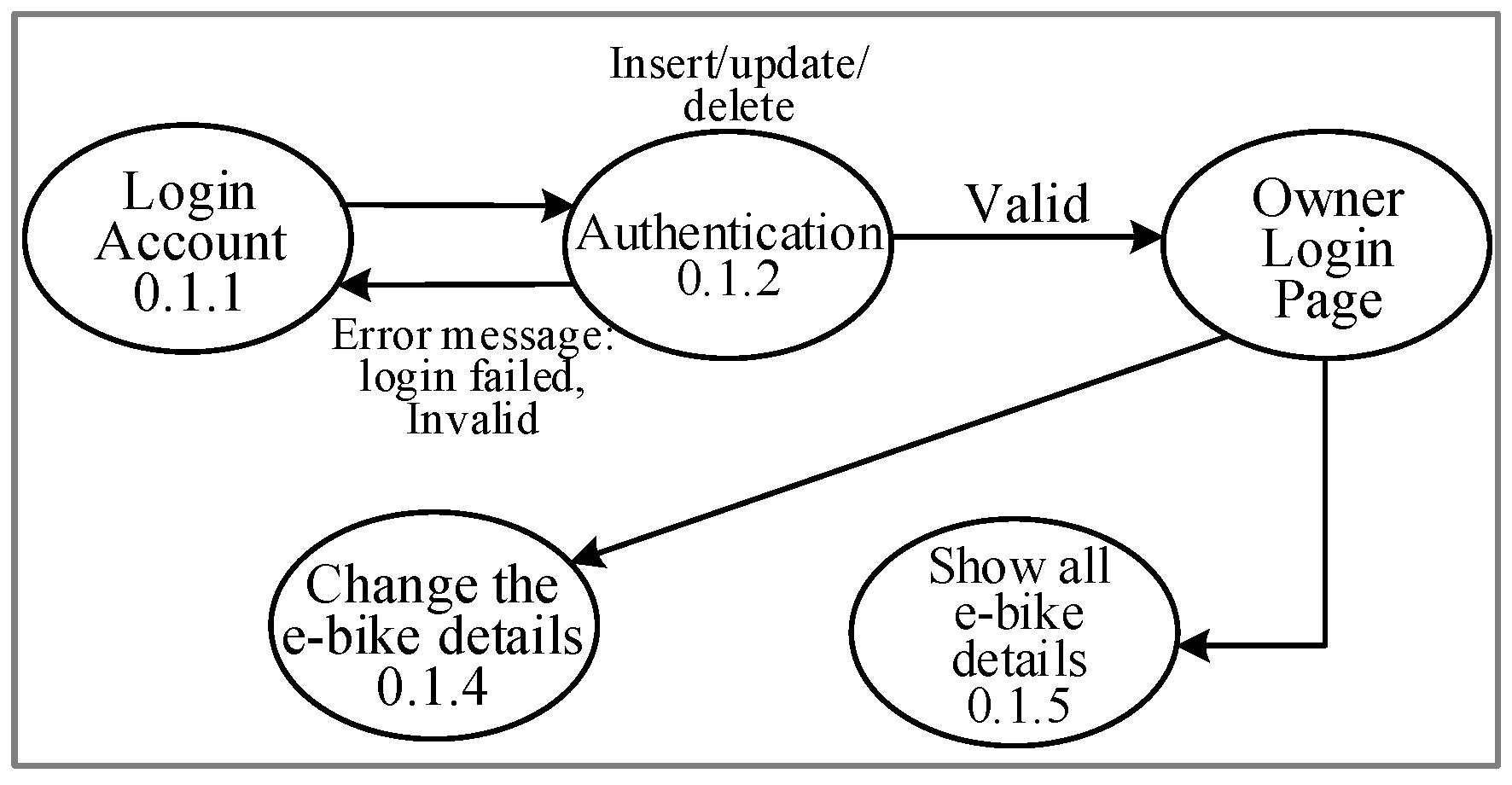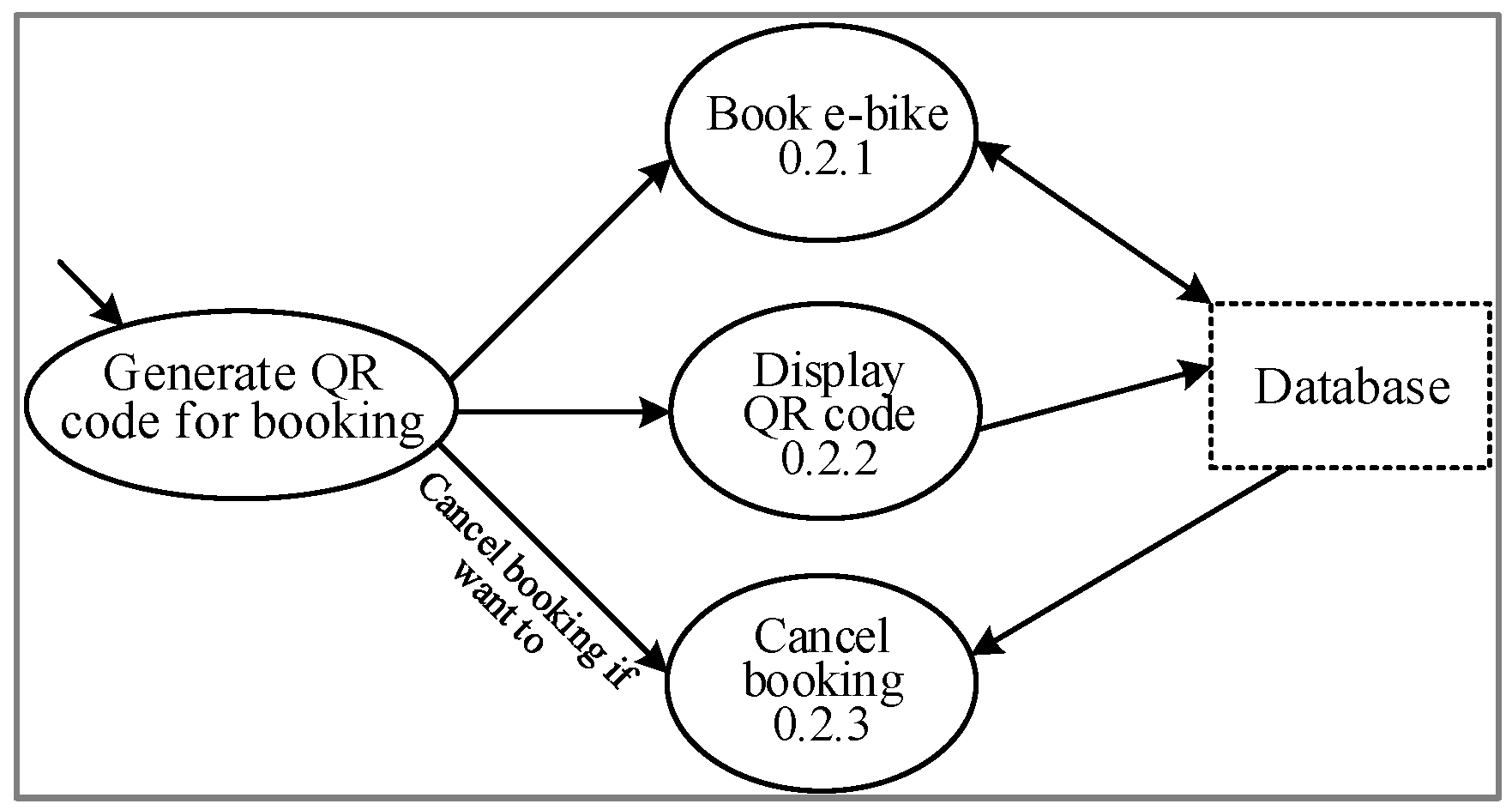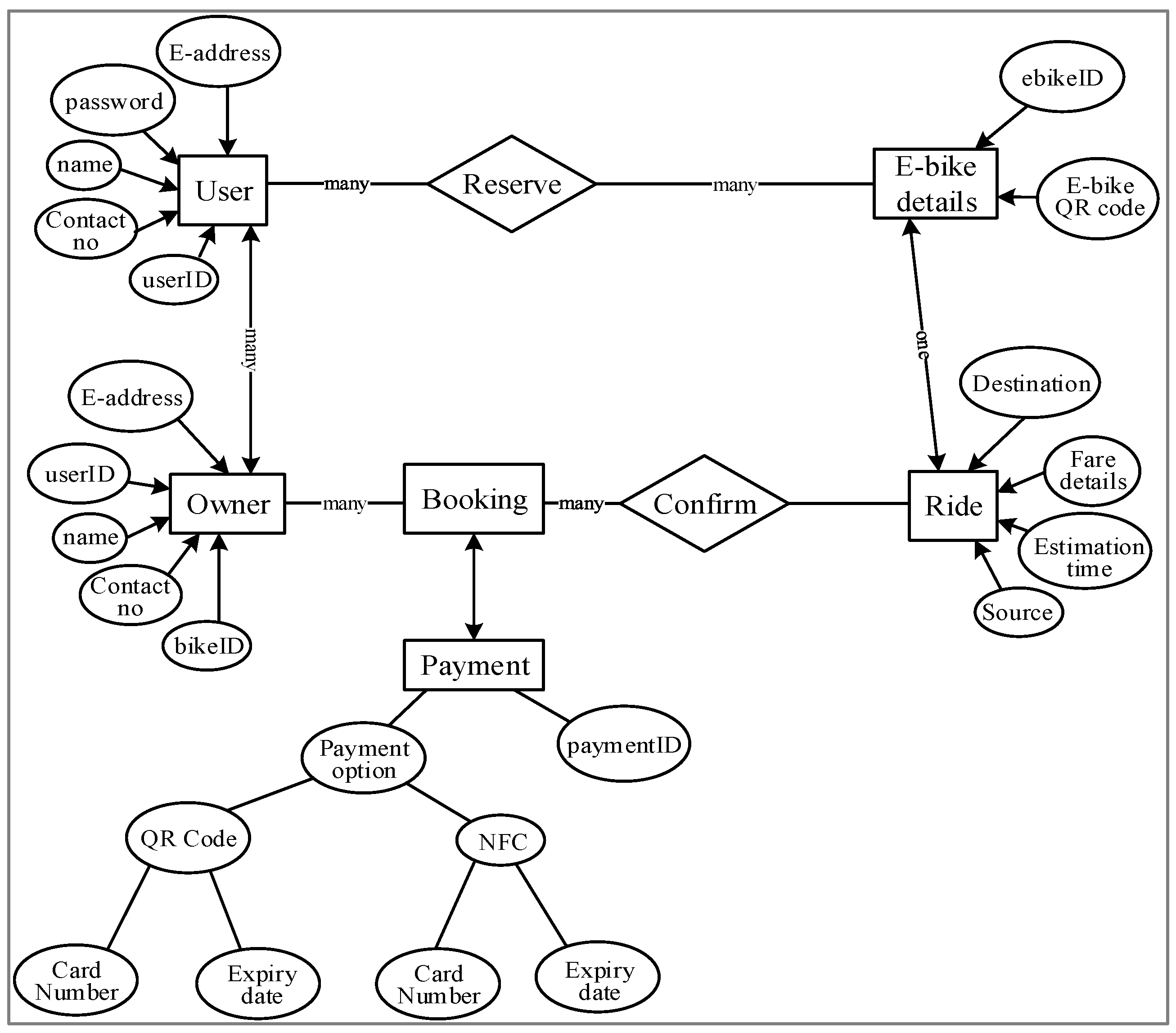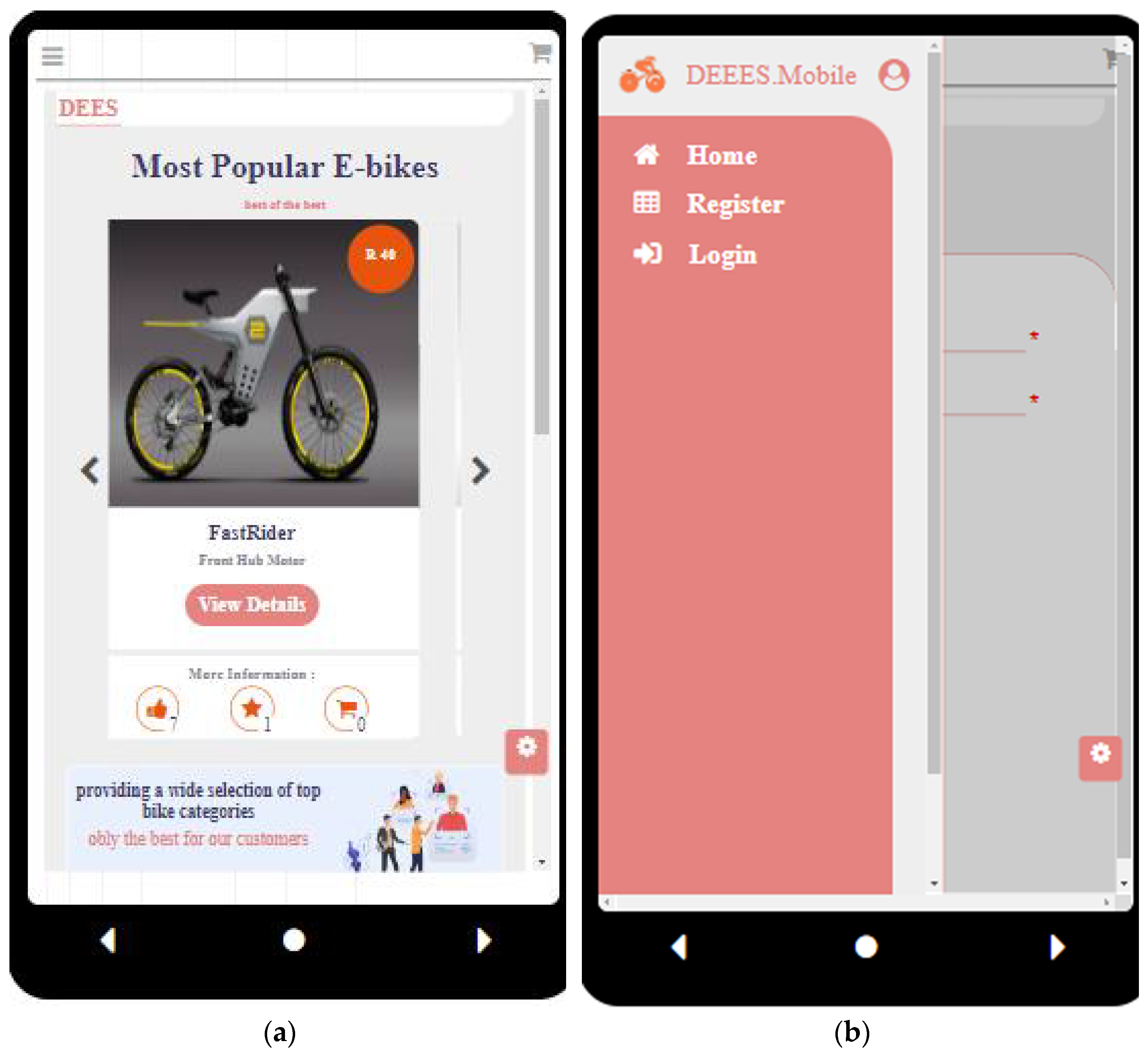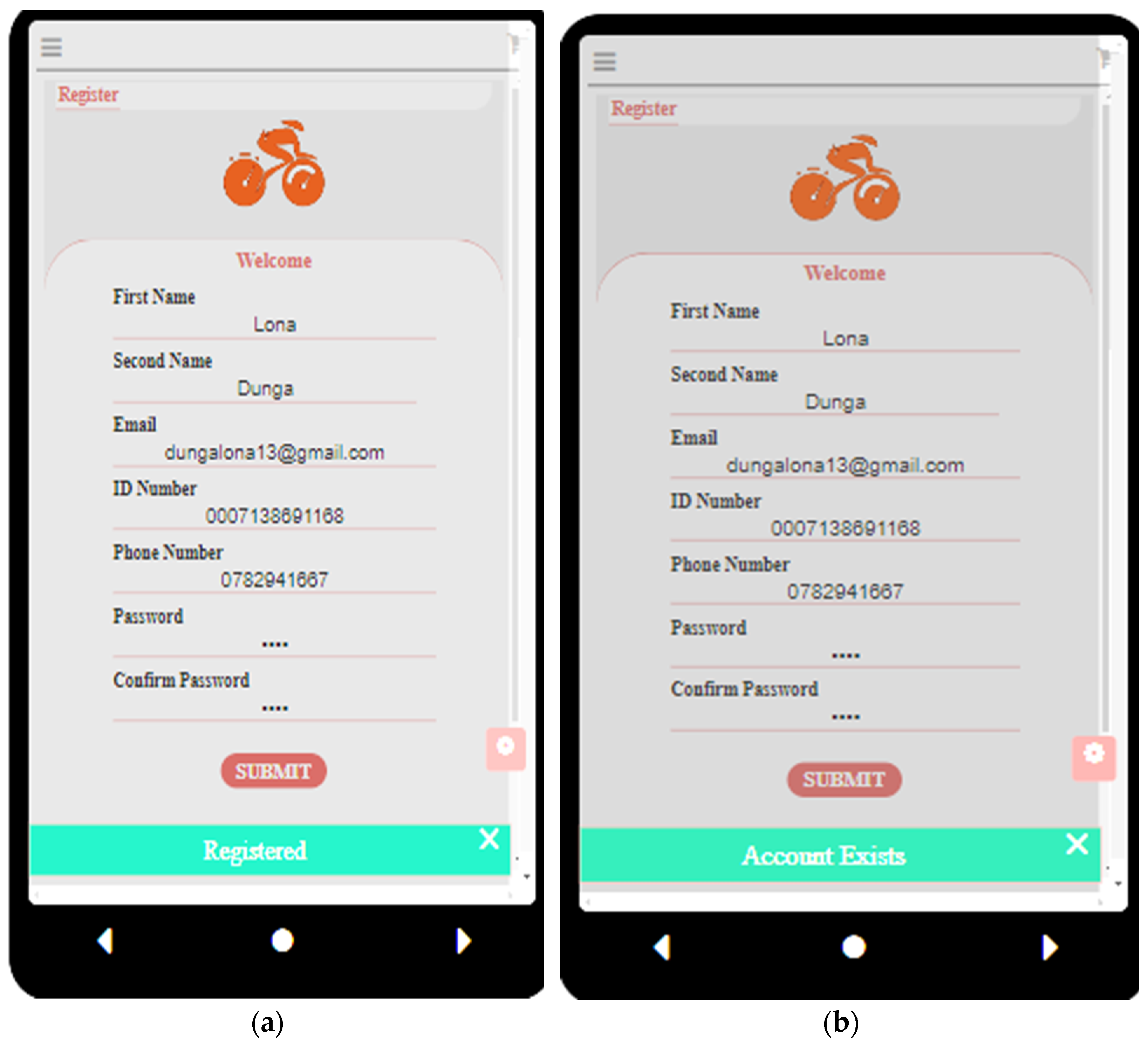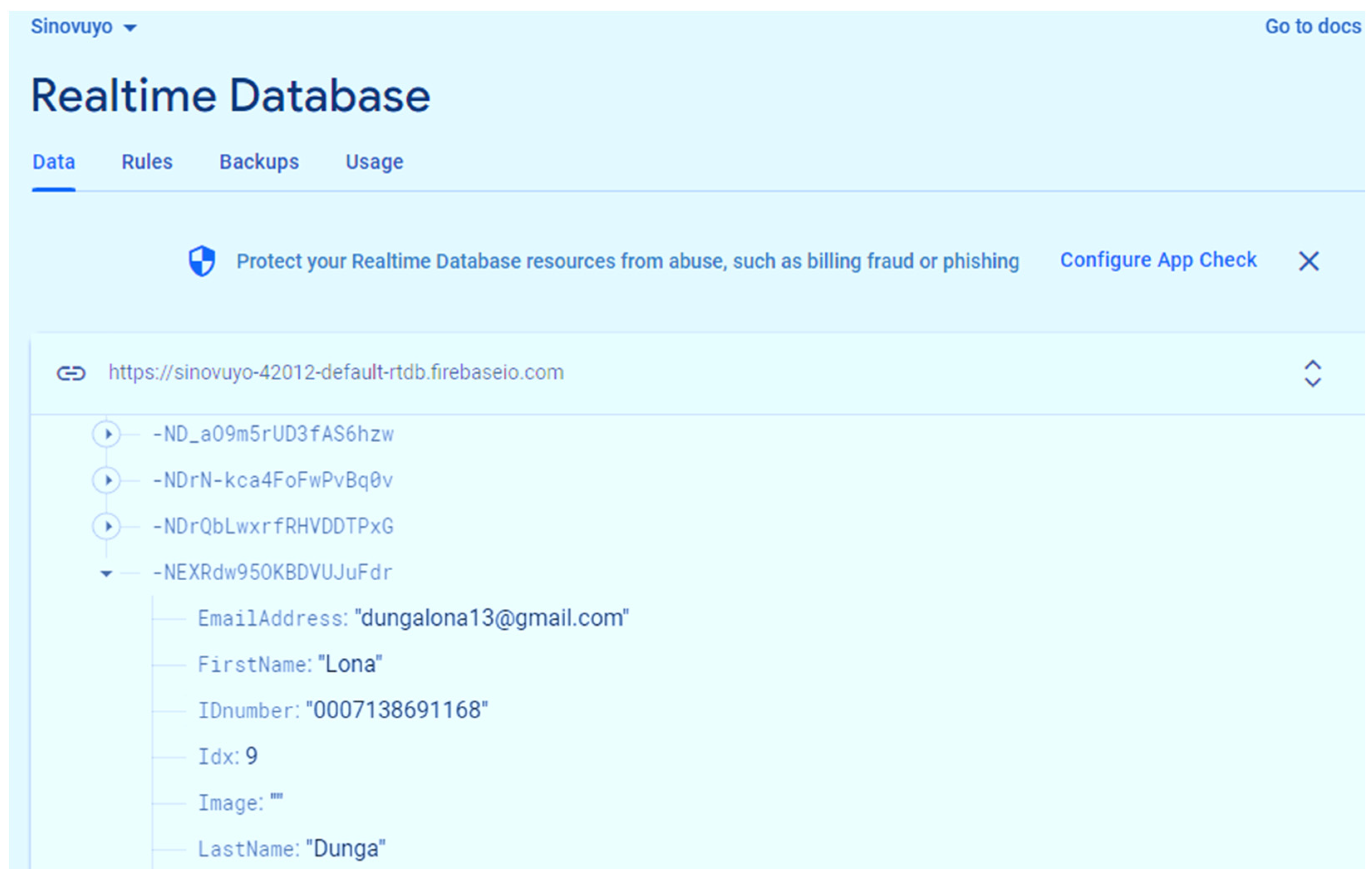1. Introduction
In South Africa, there has been an increase in demand for easy, accessible, and cheap transportation [
1]. The traditional means of transportation through fossil fuels releases pollutants, which have negative impacts on the environment and climate change. E-hailing services have been introduced and adopted by different communities and have proven to be thriving. These services are convenient; however, they do not solve the traffic congestion we have and do not make use of renewable energy sources and, thus, are mostly affected during rotational loadshedding.
Existing mobile applications for e-hailing services including rental and online payments allow transaction payments to only be made when a user is online and through the insertion of card details online. However, the recent malicious acts of hackers have shown that this means of transaction has proven to be unsafe, exposing the user to scams. In addition, it puts the user at risk for fraud, and credit or debit card theft, and customers’ details can be used for malicious activities without their consent. Third-party access to this vital information can lead to the data being sold or used for fraudulent activities. However, with the evolution of smart cities, hard cash has become the least used form of payment for services. Transactions and tasks are currently being digitalized [
2].
In Asian countries, the instant use of Quick Response (QR) payments for purchasing items from vendors has been recorded. So, vendors do not incur additional costs to pay to card companies. This is convenient for users as they are not exposed to security breaches associated with card payments and, moreover, encourages the use of smart devices [
3]. The use of QR and Near-Field Communication (NFC) for payments, as shown in the literature, encourages the use of smart technologies that are aligned with the Fourth Industrial Revolution (4IR). The adoption of these technologies acts as a gateway for new research in renewable energy and the interlink of technologies that are advanced and easy to use. In South Africa, the adoption of these technologies is an advantage as we are at the peak of going green by 2030 according to the World Bank [
4]. It provides opportunities for employment and the reduction in traffic congestion.
Quick Response (QR) is a two-dimensional barcode that stores data. It allows for contactless payment where one scans the QR code from a mobile application. When the QR code is scanned, the horizontal and vertical patterns are decoded by the software of the smart devices into a string of characters that allows for confirmation of payment [
5]. Near-Field Communication (NFC) is a wireless communication technology that allows data transfers over a distance of 4 cm based on the ISO/IEC 18092 standards [
6]. It also allows for contactless payments and bookings. These technologies are currently being deployed in most of the developed countries. However, the usage in South Africa for e-hailing services is limited. And the focus on the adoption into e-bike renting has not been recorded in the literature.
Therefore, the aim of this study is to carry out a detailed design of a booking and payment mobile application using a Quick Response code and Near-Field Communication for inter-campus electric bikes to ensure the availability of an inexpensive and convenient renewable mode of transportation. This was performed to reduce the stress experienced and time that students spend while transporting from one university campus to another. Electric bikes are not only beneficial environmentally, but also economically. While automating the process of renting and payment for the use of e-bikes, as well as avoiding traffic congestion during peak hours, a QR and NFC booking and payment application for electric bikes was designed and implemented. The system’s front-end (client side) and backend were designed using open-source technology. Object-orientated programming was used as one of the programming languages for development. This allows for fast computation and reliability of the system. This application would also save each student an average of 10 h weekly. This is useful time that the students can spend on productive activities such as reading and assignments.
3. Design Flowchart
The detailed design is designed on ASP.NET. The Data Flow Diagram (DFD) shown in
Figure 2,
Figure 3,
Figure 4,
Figure 5,
Figure 6,
Figure 7,
Figure 8,
Figure 9 and
Figure 10 presents the process of booking an e-bike ride through the mobile application. The oval shape represents the entity or user. The boxes represent the process that shows the number of processes and its description.
Figure 2 displays the homepage of the mobile application for the three actors: admin, customers, and the visitor. The visitors are those who are visiting this app homepage for the first time, while the customers are the returning clients who have already signed up on the booking page.
Figure 3 shows the user booking window before confirming booking while
Figure 4 shows the administrator database page.
During the DFD Level 0 phase, the layout of the architectural design for the mobile application is presented. The context diagram describes how the project interacts with the environment. The external entities and data flowing in and out of the system are clearly outlaid.
Figure 5 and
Figure 6 show the NFC/QR booking and Payment architectural structure.
During the DFD Level, the data flow diagram for this stage is used to register or decline new users. On the admin database, the availability of e-bikes can be confirmed, as well as whether an existing user can gain access. The DFD is shown in
Figure 7. This diagram shows the DFD for a Registered User using a QR/NFC code.
Figure 8 shows how the data flow diagram is designed for the administrator side.
During the Data Flow Diagram Level 2,
Figure 9 shows the data diagram design for the application. The relationship diagram,
Figure 10, shows the entity relationship diagram that represents the visual presentation that facilitates the database by allowing the specifications of the mobile application schema to represent the overall structure of the data. This diagram also shows the class diagram that represents the structure of the system. It displays the systems classes, attributes, and operations within the environment as well as the relationship among the system.
4. Testing and Results
There has been an increase in demand for contactless and instant payment applications that use new technology such as Quick Response and Near-Field Communication. These technologies minimize costs related to the technology use and are highly secured through encryption. A user can make the payment offline by scanning the QR code that takes them to a third-party payment gateway to process the payment. The method promotes hygiene, especially in pandemic situations. It is also safer; administrators are not required to keep records of payment details and it increases operational efficiency.
Therefore, in the simulation of different scenarios, different contingencies are put in place to ascertain the quality and assurance of this design and to present an overview of the design specifications and coding. The overall purpose is to verify and validate the various microservices to ensure that the requirements are met.
During the validation stages, different rules and regulation are put in place:
Records cannot be taken until all the necessary entities are performed.
Only the owner can edit the e-bike and user details, register new users, and/or delete existing members.
For security reasons, the user’s e-mail address and contact details are required for cases when login details are forgotten and need to be retrieved.
The experiments are divided into two sections: functionality, which is used to evaluate whether the system works as expected, and performance, which evaluates how well the system works with the design. Experiments are conducted for the following subsystems: Index page, Home page, Register page, Login page, Products, Cart, Checkout, and Firestore Database.
The number of tables utilized and their architecture layout are determined by the logical relationship in the data supplied. The database model outlines the numerous tables that are utilized as well as the data that are kept in the tables. Formats of the fields and their types of data structure as well as the user information are also taken into consideration, as shown in
Table 2 and
Table 3. The table represents the database and the data types that are used for the design of the mobile application.
This is where the user interacts with the application before registration and rental of the electric bike. HyperText Markup Language (HTML) is used to structure the web pages and the content for the application. The .html extension contains information about the landing page with information about the products, categories, and the most used e-bikes.
The application displays the front page containing information about the different electric bikes for use with the respective information. The user can scroll on the sides to view the different e-bikes.
Figure 11a displays the client-side page with the different electric bike options for rental. The application displays the home page linked with the index page that contains the layout information about the electric bikes that can be used. The user can scroll on the sides to view the different e-bikes. A front-end page is provided where the visitor can insert their details to be stored in the database. The application registers a visitor successfully and stores their details on the firestore database (
Figure 11b).
Figure 11b represents the mobile application dashboard that the visitor can see. This page contains the home page to view the different electric bikes and the registration page with the registration form to become a new customer. The purpose of the login page is to allow the user to gain access to the application by entering their e-mail address and password, as shown in
Figure 12a. The application is expected to allow the registered customer to log in. The database is expected to store the account details of the user. In a scenario where an already registered user refills the register form, a message that says that the account exists will pop-up (as shown in
Figure 12) because the database holds the details (
Figure 13).
The purpose of the product page is to display the different electric bikes. The search button can be used to search for an electric bike by either name, price, or category. The programming of this study allows for the products to be selected and be added to the cart. The Quick Response code connected to the different products is also created in javascript. The images of the bikes are stored in a string and a QR code can be generated with the different products for payment. The purpose of the cart page is to allow the user to see the products that have been added to the rental cart. It contains the details of the electric bikes and the price before the customer pays.
A products page file with an extension file of .html is created in visual studio code. The customer adds the electric bikes to the cart. The application asks the user to insert the user time, start location, and the destination location. After the user has inserted the details, a list of the added products is displayed on the screen with the estimated price before the customer pays for the rental. The database is created on firestore and one of the limitations of using the database includes the 1 MB limit per document. The user details are saved in the database (details in
Appendix A). This work contributes toward the role that the electronic booking and payment system would have in attaining the Just Energy Transition goal of the government of South Africa in the transport sector [
14,
15,
16]. Furthermore, it also saves an average of 10 h weekly per student spent in the queue for campus buses. The students can use this saved time to perform other productive activities that can enhance their academic performance and social development. Other functionalities of the app are presented in
Appendix B.
5. Conclusions
This study made use of HTML, CSS, Javascript, NodeJS and ASP.Net applications to design a seamless coordination of an e-bike rental system. An application software was designed to register visitors, encrypt their details, and make them become users. The users can make payments through a QR code and NFC module via the stripe third payment merchant. The system was able to provide feedback to the administrator on the use of the e-bike. Users can share their experiences via the feedback section and the firestore database is able to show statistical data for use of the e-bikes.
In conclusion, the implementation of the QR and NFC booking and payment platform for e-bikes is a significant step toward improving the overall experience of e-bike riders. This solution simplifies the booking process and enables riders to make payments seamlessly without the need for cash or credit cards. The QR code and NFC technology offer a convenient, fast, and secure way of making transactions, making it an ideal solution for the current digital era in transportation. Moreover, this technology will encourage more people to use e-bikes; reduce traffic congestion on four-wheel trains; make students arrive on time for their lectures, tests, and exams; and promote sustainable transportation. Just as it can offer time savings for the students, it can do the same for others when deployed in a city, hence offering time savings that can be used for other productive and economic activities. Overall, the QR and NFC booking and payment platform is a game-changer for the e-bike industry, and it is expected to revolutionize the way we move around cities.

